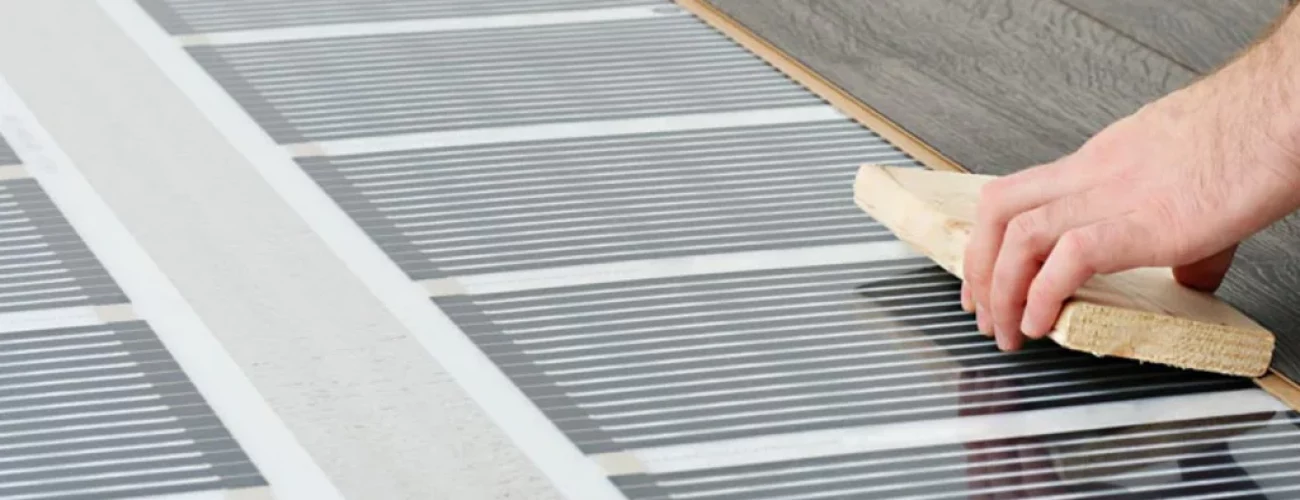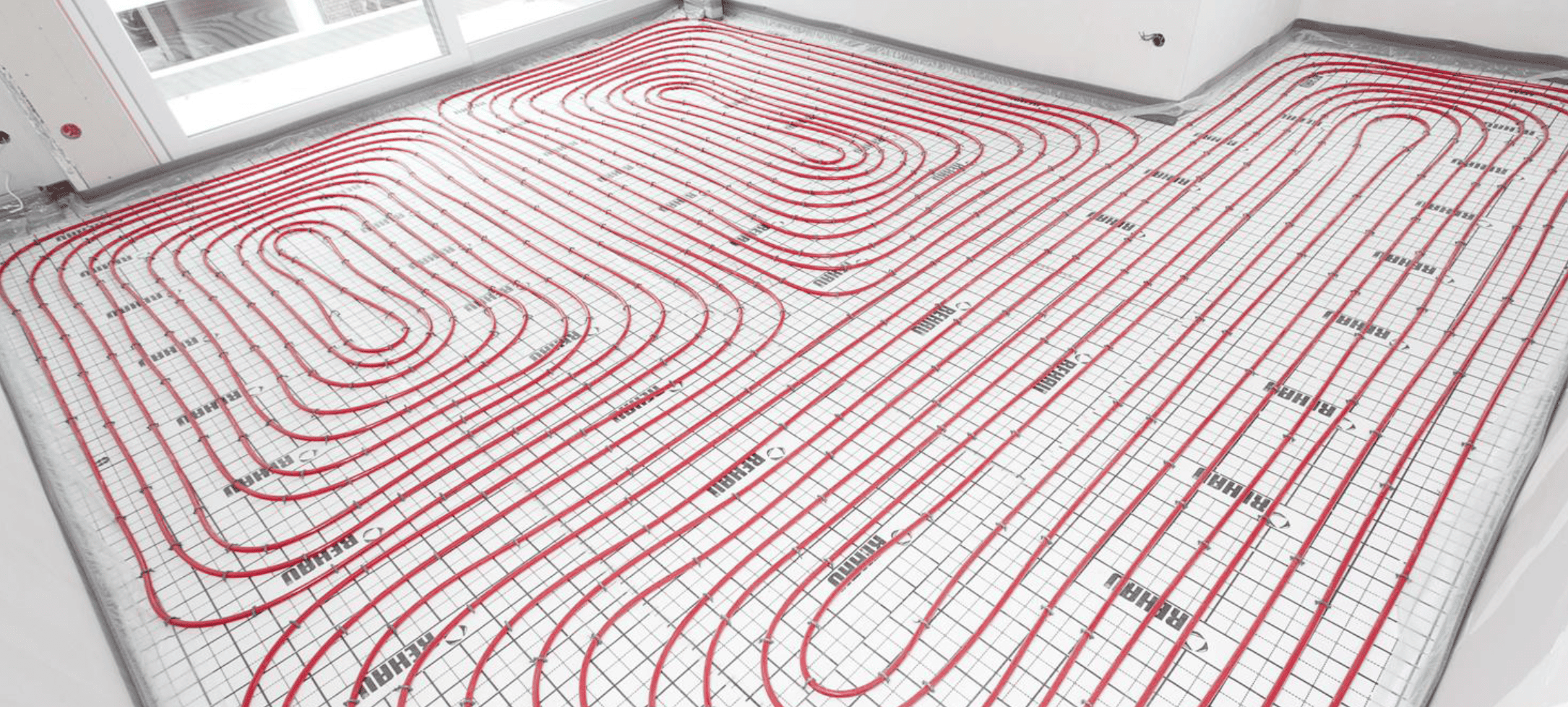- Infrared heating generates fewer carbon emissions than gas boilers
- Infrared heating systems only take 3-5 minutes to get up to full heat intensity
- Infrared underfloor heating generally costs around £75 per square metre
In the realm of domestic heating, infrared often takes the role of an unsung hero, despite its cost-effectiveness compared to other low-emission technologies. Currently, only 17% of Brits are familiar with this environmentally friendly heating option.
If you’re contemplating the adoption of infrared heating in your home, exploring underfloor heating might be a worthwhile consideration. It proves to be efficient, requires minimal maintenance, and has the potential to significantly diminish your carbon footprint.
Our comprehensive guide below covers everything you need to understand about infrared underfloor heating – from its operational principles to anticipated costs.

What's on this page?
What is infrared underfloor heating?
Before delving into the specifics of infrared heating, let’s first explore underfloor heating. This system lives up to its name by warming your home through an installation beneath the property’s flooring.
Engineered for modern efficiency, underfloor heating operates in a more cost-effective and impactful manner compared to conventional convection heating. It achieves this by evenly distributing low-wattage energy across a substantial surface area, effectively warming the entire room.
Innovatively, manufacturers have now integrated this underfloor heating technology with the relatively recent introduction of infrared heating. These infrared underfloor heating systems function similarly to electric underfloor heating but employ radiant heating. This method directly transfers heat to objects and individuals, bypassing the conventional approach of heating the air.
How much does infrared underfloor heating cost?
According to Checkatrade, the typical expense for infrared underfloor heating is approximately £75 per square meter. Given that the average size of a UK living room is around 17.1 square meters, the installation cost for infrared underfloor heating in this space could amount to around £1,282.
It’s crucial to factor in labor costs when installing any underfloor heating system. Unlike standard infrared panels, which can be easily mounted on the wall and connected to an electric circuit, underfloor heating systems involve a somewhat more intricate installation process. This complexity adds additional expenses to the overall price.
How is infrared underfloor heating installed?
Concerning infrared underfloor heating, the preferred choice for many individuals involves the installation of infrared film beneath the flooring.
After the removal of the existing flooring, the installation of the infrared film can be carried out through the following straightforward steps:
1. Prepare the base – Before initiating the installation of the infrared heating film, the installer must place a layer of insulating material on the base to prevent heat from escaping through the floor slabs.
2. Lay out the infrared system – With the base prepared, the installer then rolls out the infrared heating film, cutting it into individual fragments that are arranged across the room.
3. Connect the system to an electrical circuit – The installer proceeds to connect a conductor to a copper clamp on each infrared film strip, facilitating the flow of electrical current.
4. Mount the control device – To ensure proper functionality of the heat regulator, the installer fixes a thermal sensor underneath the sheet of films.
Upon completing these steps and successfully testing the system for any faults, the installer can replace the flooring on top of the film.
Given that infrared heating film boasts a lifespan of 45-50 years, there is no immediate concern about needing to replace it.
Advantages and disadvantages of infrared underfloor heating
| Pros | Cons |
|---|---|
| Reduces emissions | It’s expensive |
| Low maintenance | Property needs to be well insulated |
| More efficient than central heating systems | You can’t ‘zone’ your heating |
| Doesn’t ruin aesthetics | Runs on electricity, which is expensive |
| Suitable for most homes | |
| No noise pollution | |
| Can be paired with solar panels |
Advantages of infrared underfloor heating
Reduces emissions
Currently, 49% of UK residents express being ‘very anxious’ or ‘extremely anxious’ about climate change. Fortunately, a viable approach to diminish your carbon footprint involves transitioning from a boiler to infrared panels.
Adopting infrared heating leads to a reduction in emissions by lowering overall home energy consumption. This efficiency is predominantly attributed to the high efficiency rating of the panels, with some of the top-performing infrared panels in the market boasting a rating of 100%.
Low maintenance
Due to the absence of moving components in an infrared heating system, the risk of wear and tear is minimal. In numerous instances, there may not even be a requirement for regular servicing of an infrared system, distinguishing it from boilers and heat pumps.
More efficient than central heating systems
Infrared heating systems heat objects directly instead of warming the air, eliminating the need for an intermediary process and rendering them more efficient compared to central heating systems.
Additionally, these systems usually achieve full heat intensity within a short span of three to five minutes, eliminating the need for prolonged waiting periods to experience warmth.
Doesn’t ruin aesthetics
Concerned about your home’s aesthetics being affected by your heating system? With infrared underfloor heating, this won’t be a concern. There won’t be any conspicuous radiators or boilers scattered throughout the house; instead, your underfloor heating system will remain entirely out of sight.
Suitable for most homes
Underfloor heating systems are applicable to a wide range of properties in the UK, from contemporary new constructions to classic cottages. Nevertheless, the system’s effectiveness is contingent on the property being adequately insulated.
For those residing in listed properties, the option of installing infrared underfloor heating systems is viable without compromising the overall appearance of the house. However, keep in mind that temporary removal of the existing flooring is necessary for installation, requiring approval for such alterations.
No noise pollution
The operation of infrared underfloor heating is noiseless due to the absence of moving parts in the system. This quality is especially beneficial for individuals residing in apartment buildings or serene neighborhoods.
Can be paired with solar panels
Looking to take additional steps? Further reduce both your bills and carbon footprint by combining an infrared underfloor heating system with solar panels.
For those with an existing solar panel setup, connecting the infrared system to the electrical circuit simply requires the services of an installer. However, individuals without solar panels on their property may need to invest thousands of pounds to install them initially.
Want to learn more? Check out our Solar Panel Costs page for more information.
Disadvantages of infrared underfloor heating
It’s expensive
The expenses associated with underfloor heating can accumulate rapidly, with a rate of £75 per square meter. However, the total cost will be contingent on the number of rooms you intend to have it cover.
Additionally, it’s essential to factor in the expenses related to removing existing carpets and flooring before installation, along with the costs of refitting the flooring afterward.
Your property needs to be well insulated
Numerous homeowners may find it necessary to incorporate an additional layer of insulation into their homes before installing a new heating system, ensuring its effectiveness. The associated costs for this step can range from a few hundred to several thousand pounds for homeowners.
You can’t ‘zone’ your heating
Conventional infrared heating panels, positioned on the ceiling or wall, can be effortlessly activated or deactivated with a switch. This grants homeowners the flexibility of “zoning” their heating, allowing them to heat specific rooms rather than the entire house.
However, this zoning feature is not applicable to infrared underfloor heating—it operates on an all-or-nothing principle.
If you are considering the advantages of heating zoning, opting for regular infrared heating panels would be more suitable for your property.
Runs on electricity, which is expensive
While infrared heating systems boast a commendable efficiency rating that can contribute to reduced energy consumption, it’s crucial to note that they operate on electricity.
Given the ongoing energy crisis, all fuel sources have become more costly than usual. Notably, electricity is considerably more expensive than other fuels. Unfortunately, this implies that individuals transitioning from a gas boiler to infrared heating might experience an upturn in their energy bills.
Infrared vs electric underfloor heating
Infrared underfloor heating closely resembles its electric counterpart, operating in precisely the same manner. The key distinction lies in the fact that infrared emits radiation to directly heat objects instead of warming the air.
Infrared offers several advantages that electric underfloor heating cannot match. Primarily, it proves to be a significantly more efficient heating method, resulting in greater energy savings over time, as detailed in the table below.
| Heating system | Wattage (kW) | Cost to purchase | Operating cost |
|---|---|---|---|
| Underfloor electric heating 100W per m² | 2.2 | £1,410** | £1.54 per day |
| Underfloor electric heating 200W per m² | 4.4 | £1,612** | £3.08 per day |
| Infrared heating panel | 1.2–1.4 | £687 | £0.94 per day |
*These costs, sourced from Herschel, aren’t subject to energy crisis increases and are based on a living room size of 4×5.6 metres
**This price excludes insulation and substrate layers required for underfloor heating
Is your home suitable for infrared underfloor heating?
If the idea of infrared underfloor heating is appealing for your home, you’re in good fortune, as it is compatible with most UK properties.
Underfloor heating can be integrated into both new and existing properties. It’s important to note that the existing floor, whether tile, laminate, or vinyl, will need to be removed and replaced, a step that may be restricted in listed buildings.
Infrared underfloor heating systems are versatile and can be installed in every room of your home, whether it be on the ground floor, basement, or upper levels.
Next steps
Though the upfront expenses and installation efforts associated with underfloor heating may dissuade some individuals, the enduring advantages justify the investment.
Moreover, when you pair underfloor heating with a heat pump, you can significantly diminish your carbon emissions and simultaneously decrease reliance on the gas grid.
Get FREE Underfloor Heating
Find out how much an Underfloor Heating System would cost you
Complete A Short Form – Receive Free Quotes – Compare & Save
Get FREE Underfloor Heating Quotes
Find out how much an Underfloor Heating System would cost you
Complete A Short Form – Receive Free Quotes – Compare & Save






